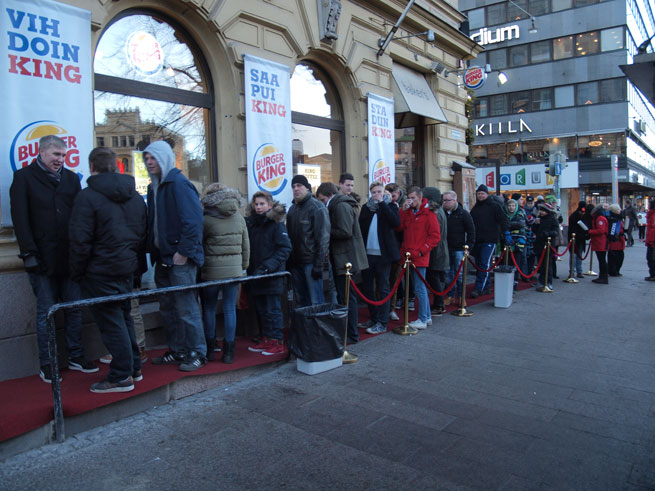 People waited for half-an-hour in a queue when Burger King returned to Finland - but how long would they have been able to last before having to give in and head for a McDonalds?
People waited for half-an-hour in a queue when Burger King returned to Finland - but how long would they have been able to last before having to give in and head for a McDonalds?
Rita Chretien, a Canadian woman survived being stranded inside a vehicle in Nevada for 48 days, by eating only some trail mix and candy, and drinking water from a stream. Apparently, she and her husband were following their GPS instructions on their way to Las Vegas from British Columbia when they took a rural road that essentially turns to a bog in the winter months. Their van eventually got stuck in the mud in the middle of nowhere, and they both waited for help for 3 days without sighting anyone. At this point, Albert Chretien, the husband, left to seek out help, while Rita remained inside the van. When she was found by a group of hunters just last week, she was nearly dead and had lost some 30lbs. Her husband remains to be found.
This recent story of near complete starvation highlights the human ability to survive for long periods of time without sustenance.
Due to obvious ethical concerns, there is not a whole lot of credible scientific data on the topic of starvation and survival. Instead, there are many accounts of either voluntary or involuntary cases of complete or near-complete starvation that allow us to make some very general conclusions.
One of the most well known cases of voluntary starvation, is the hunger strike of Mahatma Ganhdi. During his protest, Gandhi ate absolutely no food and only took sips of water for 21 days, and survived. What extraordinary about this case is the fact that Gandhi was very lean when he started his hunger-strike, thus not having much energy reserve from the outset. Also, it must be noted that during his life, Gandhi is reported to have performed a total of 14 hunger strikes.
In a 1997 editorial in the British Medical Journal, Peel briefly reviewed the available literature regarding human starvation. Generally, it appears as though humans can survive without any food for 30-40 days, as long as they are properly hydrated. Severe symptoms of starvation begin around 35-40 days, and as highlighted by the hunger strikers of the Maze Prison in Belfast in the 1980s, death can occur at around 45 to 61 days.
The most common cause of death in these extreme cases of starvation is myocardial infarction or organ failure, and is suggested to occur most often when a person’s body mass index (BMI) reaches approximately 12.5 kg/m2.
Of course, one would expect marked variability between 2 individuals in their ability to endure starvation. As suggested in a Scientific American article by Alan Lieberson,
The duration of survival without food is greatly influenced by factors such as body weight, genetic variation, other health considerations and, most importantly, the presence or absence of dehydration.
I would add that body composition would also likely play a key role; for the same body weight, the individual with a greater percentage of body fat has a greater on-board storage of calories. Also, a lower muscle mass would generally be associated with reduced caloric consumption. This by extension would suggest that females may have a survival advantage over males due to their greater relative fat stores.
Most important factor of all, however, appears to be hydration.
In the example that started this post, Rita Chretien survived her 48 day ordeal in large part due to the availability to some melted snow for drinking. Indeed, had no water been available, Rita may not have fared as well. In examples of hospitalized individuals who are in a persistent vegetative state, who become cut off from artificial sustenance, death ensues within 10-14 days. Keep in mind that these individuals are in a coma and completely immobile, thereby consuming the lowest amount of energy possible. It can thus be surmised that the same conditions (no food or water) in a person who is at least somewhat active, and who may perspire, would only lead to a much swifter end.
For individuals who like to get out into the wilderness, and who upon reading accounts of other’s misadventures (Into the Wild, 127 Hours, etc.) are not in the least discouraged from following suit (present company included), ensuring to always have a reasonable supply of water should be priority number one. Additionally, as is well documented in the eventual demise of Christopher McCandless (Into the Wild) the avoidance of eating unknown plants and shrubs can also be a key survival strategy.
This article was originally published at ObesityPanacea at the PLOS blog network
Rate and Review
Rate this audio
Review this audio
Log into OpenLearn to leave reviews and join in the conversation.
Audio reviews